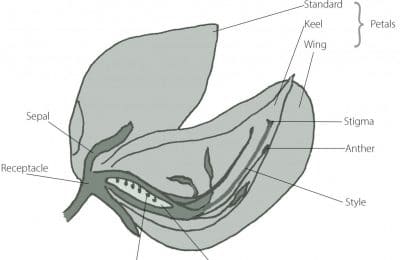RHS Level 3 Garden Planning, Construction and Planting:
R3112- Understanding the Selection and Use of Landscaping Elements in the Garden
Q.2. a – Evaluate the suitability of hard landscaping features in a garden for use of people who are visually impaired. (6)
b – Describe TWO scented plants from different genera to include in a garden for the visually impaired. (4)
RHS Examiners Feedback
The RHS examiners note that key aspects to consider here are to ‘assist safe access and maximise participation and enjoyment.’ They note that garden designers must ‘consider all aspects of a garden, so candidates who evaluated a range of features obtained the highest marks… Many candidates limited their evaluation to aspects of safety, surface materials and getting around, without much consideration of the practical solutions for the visually impaired gardener’. They were also keen to see a discussion of materials and plant choices that engaged several senses – sound, smell and touch.
Sample Answers
Answers below are longer than would be required, but are intended to give a sense of the full range of elements you might consider:
a) Designing a garden for the visually impaired gardener or garden visitor may involve a number of elements, including:
- Planning the garden with straight paths and borders, which make it easier to get around, and using ‘landmarks’ such as scented or tactile plants, wind chimes, or items such as benches as a guide around the garden.
- For the visually impaired gardener, consider creating borders that can be reached across easily, for instance no more than (2 foot) wide if you have access from one side.
- Container planting and raised beds may also be easier to manage for many visually impaired gardeners. Heights can be varied, allowing them to bring the garden to the best height for them.
- Path surfaces should be firm, level, non-glare and non-slip when wet or dry. Hard surfaces must have a well-consolidated sub-base to avoid the surface cracking, moving or rutting. Suitable materials include: in-situ concrete, asphalt and tarmac, hoggin, and self-binding gravel.
- Paths can also be edged with a low kerb to keep soil in the borders and is helpful for visitors or gardeners who use a cane.
- Consider replacing steps with a ramp, which are much safer for the visually impaired visitor. A ramp gradient of 1.15 is recommended as a general guide. Both steps and ramps are easier to use if they have a sturdy handrail.
- It can be helpful to highlight step and path edges and fencing with white paint.
- Strong colour contrasts and strong shapes in planting can create a planting design that is more enjoyable for the visually impaired, for example, pale plant colours against a dark coloured shrub or fence. Many people with sight loss find that yellow, white and blue flowers work best.
- Introduce plants and other features to engage the full range of sense – sound, for instance wind chimes, a low-maintenance water feature or plants with rattling seed heads; touch – for instance, a range of textured surfaces or tactile plants, e.g. with soft feathery leaves; and smell – introducing scented plants into the planting design.
b) List and describe two plants here; possible plants you could include here include:
- Curry plant, Helichrysum italicum – curry smelling leaves which give off a spicy aroma on a warm, sunny day. Prefers a sunny, sheltered position on well-drained soil. Regular pruning is necessary to maintain a compact plant.
- Lavender, Lavandula angustifolia – an easy to grow, evergreen shrub that produces masses of beautifully scented flowers above green or silvery-grey foliage. This drought-tolerant plant thrives in a sunny border, container or herb garden.
- Chocolate cosmos, Cosmos atrosanguineus; beautiful, maroon flowers give off a chocolate/vanilla scent. Grow in a moderately fertile, moist but well-drained soil in full sun.
- Lemon scented geranium, Pelargonium crispum; crinkly leaves that smell of lemon when rubbed. Does well in clay, loamy, or sandy soil, as long as it is well-drained. Soil pH is Alkaline, Neutral. Grows best in a sheltered position in full sun.
Background and Further Resources:
This question explores to areas – first accessibility, and second, ideas about the sensory garden. Although it might be argued that every garden includes sensory elements, the sensory garden is designed with a specific focus on introducing a range of sensory experiences.
Multisensory design is increasingly popular in gardens designed for hospital grounds, schools, residential homes and training centres.
All landscapes trigger sensory responses but it is the concentration of different experiences that gives the sensory garden it’s unique identity. Most sensory gardens are passive places, designed to be inviting and comfortable, although some are designed to be
interactive, inviting active participation by the visitor. Some may also have educational elements designed to help in teaching a range of skills.
An alternative to the sensory garden is the sensory trail. The trail has similar objects to those found in the sensory garden and is designed to offer a similar range of experiences. However, it also incorporates a sense of movement, discovery and progression which may be especially appropriate to some contexts.
The idea of a sensory garden is an ancient one:
A garden which provides fragrance as well as delighting the eye gives an extra dimension of pleasure, and one which the ancient Persian gardeners understood well. Roses were – and are – appreciated as much for their perfume as their beauty, but there are many other beautifully scented flowers. Leaves, too, on many plants are aromatic when bruised beneath the feet, rubbed between the fingers or sometimes when merely brushed against.
Howard Loxton, ‘History of the Garden’

